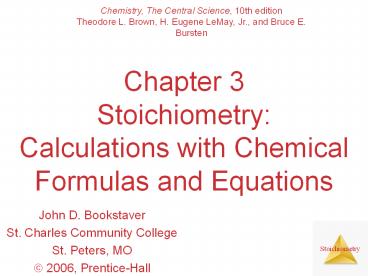Chapter 3 Stoichiometry: Calculations with Chemical Formulas and Equations - PowerPoint PPT Presentation
1 / 30
Title:
Chapter 3 Stoichiometry: Calculations with Chemical Formulas and Equations
Description:
One mole of molecules or formula units contains Avogadro's ... The coefficients in the balanced equation give the ratio of moles of reactants and products ... – PowerPoint PPT presentation
Number of Views:88
Avg rating:3.0/5.0
Title: Chapter 3 Stoichiometry: Calculations with Chemical Formulas and Equations
1
Chapter 3StoichiometryCalculations with
Chemical Formulas and Equations
Chemistry, The Central Science, 10th
edition Theodore L. Brown, H. Eugene LeMay, Jr.,
and Bruce E. Bursten
- John D. Bookstaver
- St. Charles Community College
- St. Peters, MO
- ? 2006, Prentice-Hall
2
Anatomy of a Chemical Equation
- CH4 (g) 2 O2 (g) CO2 (g) 2
H2O (g)
3
Subscripts and Coefficients Give Different
Information
- Subscripts tell the number of atoms of each
element in a molecule - Coefficients tell the number of molecules
4
Combination Reactions
- Two or more substances react to form one product
- Examples
- N2 (g) 3 H2 (g) ??? 2 NH3 (g)
- C3H6 (g) Br2 (l) ??? C3H6Br2 (l)
- 2 Mg (s) O2 (g) ??? 2 MgO (s)
5
2 Mg (s) O2 (g) ??? 2 MgO (s)
6
Decomposition Reactions
- One substance breaks down into two or more
substances
- Examples
- CaCO3 (s) ??? CaO (s) CO2 (g)
- 2 KClO3 (s) ??? 2 KCl (s) O2 (g)
- 2 NaN3 (s) ??? 2 Na (s) 3 N2 (g)
7
Combustion Reactions
- Rapid reactions that produce a flame
- Most often involve hydrocarbons reacting with
oxygen in the air
- Examples
- CH4 (g) 2 O2 (g) ??? CO2 (g) 2 H2O (g)
- C3H8 (g) 5 O2 (g) ??? 3 CO2 (g) 4 H2O (g)
8
Formula Weight (FW)
- Sum of the atomic weights for the atoms in a
chemical formula - So, the formula weight of calcium chloride,
CaCl2, would be - Ca 1(40.1 amu)
- Cl 2(35.5 amu)
- 111.1 amu
- These are generally reported for ionic compounds
9
Molecular Weight (MW)
- Sum of the atomic weights of the atoms in a
molecule - For the molecule ethane, C2H6, the molecular
weight would be
10
Percent Composition
- One can find the percentage of the mass of a
compound that comes from each of the elements in
the compound by using this equation
11
Percent Composition
- So the percentage of carbon in ethane is
12
Avogadros Number
- 6.02 x 1023
- 1 mole of 12C has a mass of 12 g
13
Molar Mass
- By definition, these are the mass of 1 mol of a
substance (i.e., g/mol) - The molar mass of an element is the mass number
for the element that we find on the periodic
table - The formula weight (in amus) will be the same
number as the molar mass (in g/mol)
14
Using Moles
- Moles provide a bridge from the molecular scale
to the real-world scale
15
Mole Relationships
- One mole of atoms, ions, or molecules contains
Avogadros number of those particles - One mole of molecules or formula units contains
Avogadros number times the number of atoms or
ions of each element in the compound
16
Calculating Empirical Formulas
- One can calculate the empirical formula from the
percent composition
17
Calculating Empirical Formulas
The compound para-aminobenzoic acid (you may have
seen it listed as PABA on your bottle of
sunscreen) is composed of carbon (61.31),
hydrogen (5.14), nitrogen (10.21), and oxygen
(23.33). Find the empirical formula of PABA.
18
Calculating Empirical Formulas
19
Calculating Empirical Formulas
20
Calculating Empirical Formulas
These are the subscripts for the empirical
formula C7H7NO2
21
Combustion Analysis
- Compounds containing C, H and O are routinely
analyzed through combustion in a chamber like
this - C is determined from the mass of CO2 produced
- H is determined from the mass of H2O produced
- O is determined by difference after the C and H
have been determined
22
Elemental Analyses
- Compounds containing other elements are analyzed
using methods analogous to those used for C, H
and O
23
Stoichiometric Calculations
- The coefficients in the balanced equation give
the ratio of moles of reactants and products
24
Stoichiometric Calculations
- From the mass of Substance A you can use the
ratio of the coefficients of A and B to calculate
the mass of Substance B formed (if its a
product) or used (if its a reactant)
25
Stoichiometric Calculations
C6H12O6 6 O2 ? 6 CO2 6 H2O
- Starting with 1.00 g of C6H12O6
- we calculate the moles of C6H12O6
- use the coefficients to find the moles of H2O
- and then turn the moles of water to grams
26
Limiting Reactants
- The limiting reactant is the reactant present in
the smallest stoichiometric amount
27
Limiting Reactants
- The limiting reactant is the reactant present in
the smallest stoichiometric amount - In other words, its the reactant youll run out
of first (in this case, the H2)
28
Limiting Reactants
- In the example below, the O2 would be the excess
reagent
29
Theoretical Yield
- The theoretical yield is the amount of product
that can be made - In other words its the amount of product
possible as calculated through the stoichiometry
problem - This is different from the actual yield, the
amount one actually produces and measures
30
Percent Yield
- A comparison of the amount actually obtained to
the amount it was possible to make

